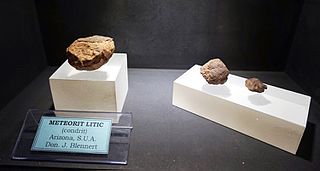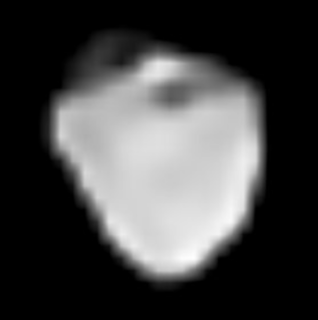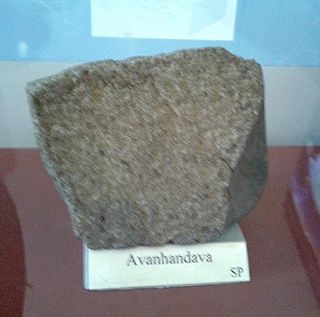Related Research Articles

The Wold Cottage meteorite fell near Wold Cottage farm in 1795, a few miles away from the village of Wold Newton in Yorkshire, England.

A meteorite classification system attempts to group similar meteorites and allows scientists to communicate with a standardized terminology when discussing them. Meteorites are classified according to a variety of characteristics, especially mineralogical, petrological, chemical, and isotopic properties.

A chondrite is a stony (non-metallic) meteorite that has not been modified, by either melting or differentiation of the parent body. They are formed when various types of dust and small grains in the early Solar System accreted to form primitive asteroids. Some such bodies that are captured in the planet’s gravity well become the most common type of meteorite by arriving on a trajectory toward the Earth’s surface. Estimates for their contribution to the total meteorite population vary between 85.7% and 86.2%.

Hebe is a large main-belt asteroid, containing around 0.5% of the mass of the belt. However, due to its apparently high bulk density, Hebe does not rank among the top twenty asteroids by volume. This high bulk density suggests an extremely solid body that has not been impacted by collisions, which is not typical of asteroids of its size – they tend to be loosely-bound rubble piles.

The H type ordinary chondrites are the most common type of meteorite, accounting for approximately 40% of all those catalogued, 46% of the ordinary chondrites, and 44% of the chondrites. The ordinary chondrites are thought to have originated from three parent asteroids, whose fragments make up the H chondrite, L chondrite and LL chondrite groups respectively.

The ordinary chondrites are a class of stony chondritic meteorites. They are by far the most numerous group and comprise about 87% of all finds. Hence, they have been dubbed "ordinary". The ordinary chondrites are thought to have originated from three parent asteroids, with the fragments making up the H chondrite, L chondrite and LL chondrite groups respectively.

The L type ordinary chondrites are the second most common group of meteorites, accounting for approximately 35% of all those catalogued, and 40% of the ordinary chondrites. The ordinary chondrites are thought to have originated from three parent asteroids, with the fragments making up the H chondrite, L chondrite and LL chondrite groups respectively.

The LL chondrites are a group of stony meteorites, the least abundant group of the ordinary chondrites, accounting for about 10–11% of observed ordinary-chondrite falls and 8–9% of all meteorite falls. The ordinary chondrites are thought to have originated from three parent asteroids, with the fragments making up the H chondrite, L chondrite and LL chondrite groups respectively. The composition of the Chelyabinsk meteorite is that of a LL chondrite meteorite. The material makeup of Itokawa, the asteroid visited by the Hayabusa spacecraft which landed on it and brought particles back to Earth also proved to be type LL chondrite.
Monte Milone is meteorite that fell in 1846 in central Italy.

The Ensisheim meteorite is a stony meteorite that fell on November 7, 1492 in a wheat field outside the walled town of Ensisheim in then Alsace, Further Austria. The meteorite can still be seen in Ensisheim's museum, the sixteenth-century Musée de la Régence.
Agen is an H chondrite meteorite that fell to earth on September 5, 1814, in Aquitaine, France.

Allegan is a type 5 H chondrite meteorite that landed in Michigan on July 10, 1899. Allegan weighed around fifty pounds after its landing. As of 1964, it was one of only seven known meteorites to land in Michigan.
Ambapur Nagla is an H chondrite meteorite that fell to earth on May 27, 1895, in Uttar Pradesh, India.

Arbol Solo is an H chondrite meteorite that fell to earth on September 11, 1954, in the province of San Luis, Argentina.
Ankober is an H chondrite meteorite that fell to Earth on July 7, 1942, in Shewa, Ethiopia.

Avanhandava is an H chondrite meteorite that fell to earth in 1952 in São Paulo, Brazil.
Benton is a meteorite found near the village of Benton, New Brunswick following a fireball. Two masses were found but the meteorites were split up. The largest fragment is now in the Canadian National Meteorite Collection, Ottawa.
The Santa Vitoria do Palmar meteorite was found near the city of Santa Vitoria do Palmar in Brazil in 2003 and 2004.

Dingle Dell is a 1.15 kg ordinary chondrite of subclass L/LL5, and the fourth meteorite to be recovered by the Desert Fireball Network camera observatory. It fell in the Morawa region of Western Australia on 31 October 2016 8:05 pm local time, and was recovered less than a week later, on the morning of 7 November, in a paddock at Dingle Dell farm. Given the rapid turnaround for meteorite recovery and a lack of rainfall between fall date and find date, the rock is in pristine condition and shows no evidence of terrestrial weathering (W0). This particular meteorite fall demonstrates the proficiency of the DFN as a sample recovery tool for meteoritics.
CM chondrites are a group of chondritic meteorites which resemble their type specimen, the Mighei meteorite. The CM is the most commonly recovered group of the 'carbonaceous chondrite' class of meteorites, though all are rarer in collections than ordinary chondrites.
References
- 1 2 Meteoritical Bulletin Database: Assisi
- ↑ Levi-Donati, G. R. (December 1967). "The mineralogical composition and structure of the Assisi meteorite". Mineralogical Magazine and Journal of the Mineralogical Society. 36 (280): 595–606. doi:10.1180/minmag.1967.036.280.13. ISSN 0369-0148.
| This meteorite-related article is a stub. You can help Wikipedia by expanding it. |